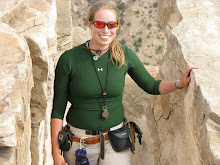Or maybe 3 . . .
 In the meantime, enjoy a close-up of the famed Neoproterozoic-era Noonday Dolomite (Mosaic Canyon, Death Valley, CA). Sorry for the lack of scale; the bands are roughly centimeter-scale. Another of the Great Geological Mysteries of the planet, its formation is contested. When we discussed possible origins while visiting the site in March 2007, the popular hypothesis was that the banding is of biogenic origin (GSA abstract for the curious). If so, it would be similar to examples of Late Archean banded iron formations (BIFs), which originated as stromatolites. Later, sediments entrained between algae layers lithified and under went diagenesis or other processes to become these BIFs. Similar processes may have produced the Noonday Dolomite.
In the meantime, enjoy a close-up of the famed Neoproterozoic-era Noonday Dolomite (Mosaic Canyon, Death Valley, CA). Sorry for the lack of scale; the bands are roughly centimeter-scale. Another of the Great Geological Mysteries of the planet, its formation is contested. When we discussed possible origins while visiting the site in March 2007, the popular hypothesis was that the banding is of biogenic origin (GSA abstract for the curious). If so, it would be similar to examples of Late Archean banded iron formations (BIFs), which originated as stromatolites. Later, sediments entrained between algae layers lithified and under went diagenesis or other processes to become these BIFs. Similar processes may have produced the Noonday Dolomite.
Mosaic Canyon is one of the many slot canyons found in Death Valley. The color and banding of the dolomite is well-preserved because of the extreme dry conditions. However, water is one of the primary forces sculpting the rock into such incredibly smooth (and really slippery!) surfaces. At left is a (kinda bad) photo looking down one of the narrow channels incised in the dolomite by fast-moving waters and sediment. Again, apologies for a lack of scale in the photo - the width of the "channel" (obviously not the main channel) is approximately a foot and a half wide. Most dolomites found in the field tend to be greyish as a result of regular weathering and are unremarkable in appearance.
Death Valley is a cool place. For a taste of some more of the myriad geologic interests of the area, check out the Wikipedia overview: Geology of Death Valley.
Webmomster had the rest of my Death Valley pictures online, but I can't seem to find them. Oh well -- ask and you shall receive!
Guess I should start packing for field camp . . .

No comments:
Post a Comment